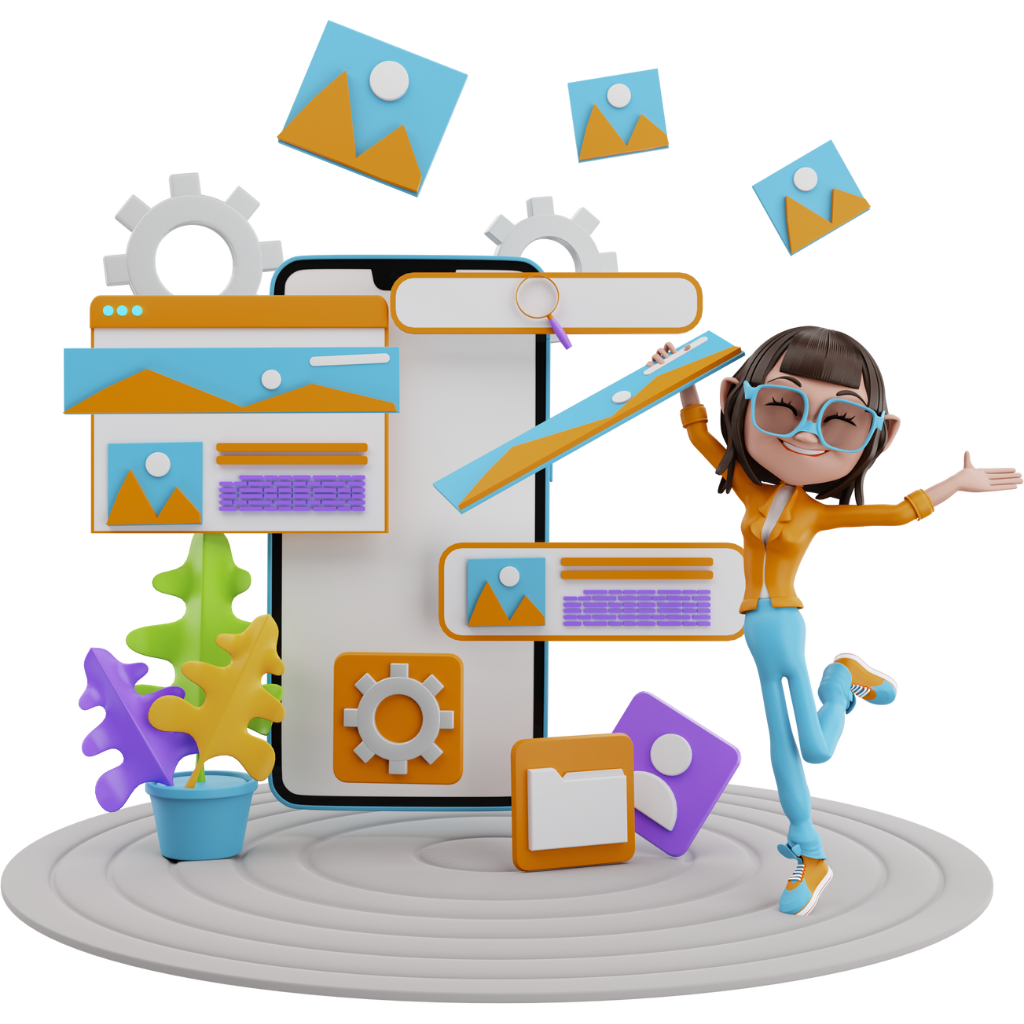Let’s be real—digital marketing can feel overwhelming. With so many strategies, trends, and platforms popping up every day, it’s easy to get lost in the noise. You might be wondering, “Where do I even start?” or “Which strategies actually work?”
Well, you’re not alone. The good news? You don’t need to do everything—you just need to focus on the right strategies. Whether you’re a small business owner, an aspiring entrepreneur, or a marketer trying to boost results, understanding the most effective digital marketing strategies can make all the difference.
In this guide, I’ll break down the best, battle-tested digital marketing strategies that can help you increase traffic, generate leads, and grow your business. Let’s start with the foundation of digital marketing: SEO.

1. Search Engine Optimization (SEO) – Your Free Traffic Machine
Imagine having a 24/7 marketing assistant that works for you without asking for a paycheck. That’s exactly what SEO does. When done right, SEO helps your website rank higher on Google, bringing you organic (free) traffic without paying for ads.
But here’s the catch—SEO isn’t just about stuffing keywords into a blog post. It’s a mix of technical skills, content strategy, and a bit of patience.
Why SEO Matters
🔹 93% of online experiences start with a search engine.
🔹 75% of people never scroll past the first page of Google.
🔹 Organic search drives more traffic than paid ads in the long run.
If you’re not optimizing for SEO, you’re basically handing over potential customers to your competitors.
SEO Strategies That Work
1. Keyword Research – The Starting Point
Before you even start writing content, you need to know what people are searching for. That’s where keyword research comes in.
Find High-Intent Keywords: Use tools like Google Keyword Planner, Ubersuggest, or Ahrefs to discover what your target audience is searching for.
Focus on Long-Tail Keywords: Instead of targeting a competitive keyword like “digital marketing”, go for specific, less competitive phrases like “best digital marketing strategies for small businesses.”
Check Search Intent: Google your keyword and analyze the top-ranking results. Are people looking for information, products, or services?
2. On-Page SEO – Make Google Love Your Content
Once you have your keywords, it’s time to optimize your content. Here’s how:
Title & Meta Description: Your title should be catchy and include your main keyword. The meta description should give a quick summary and entice people to click.
Headings (H1, H2, H3): Use structured headings to make your content easy to read.
Internal & External Links: Link to your own related blog posts and high-authority sources to boost credibility.
Image Optimization: Use alt text with keywords so Google understands your images.
Mobile-Friendliness: Google prioritizes mobile-friendly websites. Use Google’s Mobile-Friendly Test to check yours.
3. Off-Page SEO – Build Authority & Trust
Google doesn’t just rank content—it ranks authority. If other websites trust and link to you, Google sees you as a credible source.
Backlinks: Get quality backlinks from trusted websites through guest blogging, partnerships, or PR.
Social Signals: Shares and engagement on social media indirectly boost SEO.
Brand Mentions: Even if a website doesn’t link to you, a brand mention can still help.
4. Technical SEO – The Behind-the-Scenes Hero
Even if your content is top-notch, a slow, buggy website will hurt your rankings.
Improve Site Speed: Use Google PageSpeed Insights to check and fix speed issues.
Fix Broken Links & Errors: Use tools like Screaming Frog or Ahrefs to find errors.
Ensure Mobile Usability: If your site isn’t mobile-friendly, you’re losing traffic.
Quick SEO Wins You Can Apply Today
✅ Update old blog posts with fresh content and keywords.
✅ Improve your website speed by compressing images.
✅ Use an SEO-friendly URL structure (avoid messy URLs like yourwebsite.com/p=123).

2. Content Marketing – The King of Engagement
You’ve probably heard the phrase “Content is king,” right? Well, there’s a good reason for that. In today’s digital world, people don’t want to be “sold” to—they want to be educated, entertained, and inspired. That’s where content marketing comes in.
What is Content Marketing?
Content marketing is all about creating valuable, relevant, and engaging content to attract and retain an audience. Instead of pushing ads, you’re providing useful information that makes people trust your brand.
Why Content Marketing Works
Boosts SEO: Quality content ranks higher on Google, bringing in more organic traffic.
Builds Authority: When you consistently share valuable insights, people see you as an expert.
Creates Brand Loyalty: Helpful content keeps people coming back for more.
Increases Conversions: Great content guides people through the buyer’s journey and helps them make informed decisions.
Content Marketing Strategy – How to Do It Right
Creating content without a plan is like driving without a map. Here’s how to do it the right way:
1. Understand Your Audience
Who are you creating content for? What problems do they have? What type of content do they engage with? Use tools like Google Analytics, Facebook Insights, or customer surveys to get answers.
2. Plan Your Content (Content Calendar)
Random posting won’t get you results. Create a content calendar and stick to a schedule. Use tools like Trello, Notion, or Google Sheets to organize your topics, deadlines, and publishing dates.
3. Focus on Quality Over Quantity
It’s better to post one high-quality, well-researched blog per week than to publish five rushed, low-quality posts.
4. Promote Your Content
Creating content isn’t enough—you need to get it in front of people. Share it on social media, repurpose it into different formats, and encourage engagement.
5. Track Performance & Improve
Use analytics tools to track what’s working and what’s not. If a blog post isn’t ranking, update it with new information. If a video flops, tweak your approach.
Quick Wins for Content Marketing
✅ Repurpose old blog posts into videos, infographics, or social media posts.
✅ Write listicles and how-to guides (they perform well in search results).
✅ Share personal stories—people connect with authenticity.
✅ Use eye-catching visuals (nobody likes a plain wall of text!).

3. Social Media Marketing – More Than Just Posting
Let’s be honest—everyone is on social media. But here’s the problem: most businesses think that simply posting random content will get them followers, engagement, and sales. Spoiler alert: it won’t.
Social media marketing is about building relationships, engaging with your audience, and providing value. If you do it right, it can become a powerful tool for brand awareness, customer loyalty, and even direct sales.
Why Social Media Marketing is Important
Increases brand visibility – Your audience is already scrolling; meet them where they are.
Boosts engagement & trust – Interacting with your audience creates a personal connection.
Drives website traffic & conversions – Social media can direct visitors to your website, blog, or product pages.
How to Make Social Media Work for You
1. Choose the Right Platform for Your Business
Not all social media platforms are created equal. Each one has its strengths:
Instagram & TikTok → Best for visual content, influencers, and lifestyle brands.
Facebook → Great for community-building, groups, and older demographics.
LinkedIn → Ideal for B2B marketing, networking, and professional insights.
Twitter (X) → Perfect for real-time updates, trending topics, and brand interactions.
Pinterest → Amazing for DIY, fashion, beauty, and visual inspiration.
2. Post Consistently (But Focus on Quality Over Quantity)
Posting every day won’t help if your content isn’t valuable. Instead:
✅ Stick to a content schedule (3–5 quality posts per week is better than 10 rushed ones).
✅ Use a mix of content formats – videos, carousels, infographics, behind-the-scenes, and user-generated content.
✅ Engage with your audience – reply to comments, answer DMs, and start conversations.
3. Leverage User-Generated Content (UGC)
People trust other customers more than they trust brands. Encourage your followers to share their experiences using your product/service and feature their content.
4. Use Hashtags & Trends Wisely
✅ Don’t just throw in random hashtags. Use relevant ones that align with your niche.
✅ Jump on trends, but make them relevant to your audience.
5. Run Social Media Ads for Faster Growth
Organic growth is great, but social media ads can skyrocket your reach. You can target specific audiences based on:
✅ Interests & behaviors
✅ Location
✅ Retargeting people who have interacted with your business before
Quick Wins for Social Media Marketing
✅ Engage with your audience daily.
✅ Use short-form video content (Reels, TikToks, YouTube Shorts).
✅ Run interactive posts (polls, Q&As, “This or That” games).
✅ Repurpose blog posts into bite-sized social media content.

4. Email Marketing – Still a Money-Maker
If you think email marketing is dead, think again. For every $1 spent on email marketing, businesses make an average of $42. That’s an insane 4,200% ROI!
The truth is, email marketing works because it’s personal, direct, and lands straight in your audience’s inbox. Unlike social media (where algorithms decide who sees your content), YOU control your email list.
Why Email Marketing Still Works
High ROI – One of the most cost-effective marketing strategies.
Direct communication – No algorithm filters; your message lands directly in inboxes.
Automated & scalable – Once set up, it works on autopilot.
How to Create an Effective Email Marketing Strategy
1. Build Your Email List (The Right Way!)
You need an audience before you start sending emails. But don’t buy email lists—that’s a spammy practice. Instead:
✅ Offer a valuable lead magnet (a free eBook, checklist, discount, or webinar) in exchange for an email.
✅ Place signup forms on your website, blog, and social media.
✅ Use exit-intent popups to capture emails before visitors leave.
2. Write Emails That People Actually Want to Read
Nobody wants to open a boring, salesy email. Instead, write emails that are:
Conversational – Make it feel like a personal message, not a robotic promo.
Value-packed – Provide tips, insights, or exclusive deals.
Short & engaging – No one wants to read a novel in their inbox.
Example:
Instead of writing, “Check out our latest sale,” try, “Hey [First Name], we just dropped something amazing, and you get first dibs!”
3. Personalization = More Opens & Clicks
Emails with personalized subject lines are 26% more likely to be opened.
✅ Use the recipient’s name in the subject line or opening sentence.
✅ Segment your list based on interests or past purchases to send relevant emails.
4. Automate Your Emails
Save time by setting up email automation sequences. For example:
Welcome Sequence: A series of emails introducing new subscribers to your brand.
Abandoned Cart Emails: Remind shoppers to complete their purchase.
Birthday Emails: Send special discounts on their birthday.
5. Track & Optimize
Always analyze your email performance:
Open Rates: Are people opening your emails? (Aim for 20%+ open rates).
Click-Through Rates (CTR): Are they clicking on your links?
Unsubscribes: If too many people are opting out, tweak your messaging.
Quick Wins for Email Marketing
✅ Keep subject lines short & intriguing (e.g., “You’ll love this!”).
✅ Add a clear call-to-action (CTA) in every email.
✅ Send emails at optimal times (Tuesdays & Thursdays tend to perform best).
✅ Test different formats (plain-text emails sometimes work better than fancy designs).

5. Pay-Per-Click (PPC) Advertising – Instant Visibility
While SEO and content marketing take time to bring organic traffic, PPC advertising gives you instant results. It’s one of the fastest ways to get your brand in front of potential customers.
What is PPC Advertising?
PPC (Pay-Per-Click) is a form of paid advertising where you only pay when someone clicks on your ad. These ads appear at the top of search engine results, on social media, and across websites.
Why PPC Works
Instant traffic – Unlike SEO, which takes months, PPC gets you visitors immediately.
Highly targeted – Ads are shown only to people actively searching for your products/services.
Scalable – You control your budget and can adjust spending based on performance.
Best PPC Advertising Platforms
1. Google Ads – The King of PPC
Google Ads show your business at the top of search results. These work best for:
Search Ads – Appear when people search for keywords related to your business.
Display Ads – Banners/images that appear on websites in Google’s network.
YouTube Ads – Video ads before or during YouTube videos.
Example: If you run an eco-friendly skincare brand, you can target keywords like “best vegan moisturizer” so that when someone searches for it, your ad appears at the top.
2. Facebook & Instagram Ads
These platforms offer laser-focused targeting. You can target users based on:
✅ Location
✅ Age & Gender
✅ Interests & Behaviors
Best for: E-commerce brands, beauty, fashion, and lifestyle businesses.
3. LinkedIn Ads – Perfect for B2B
If you’re in the B2B space, LinkedIn Ads can target professionals by industry, job title, and company size.
How to Make PPC Work for You
✅ Start with keyword research – Use tools like Google Keyword Planner to find high-intent keywords.
✅ Write compelling ad copy – Use clear, persuasive language with a strong call to action (CTA).
✅ A/B test different ads – Run multiple variations and optimize based on performance.
✅ Use retargeting – Show ads to people who visited your website but didn’t buy.
Quick Wins for PPC Advertising
✅ Target high-intent keywords (like “buy organic sunscreen” instead of just “sunscreen”).
✅ Optimize landing pages – Make sure your ad leads to a page that converts.
✅ Keep an eye on CTR (Click-Through Rate) – If it’s low, tweak your ad copy.

6. Influencer Marketing – The Power of Trust
People trust recommendations from real people more than traditional ads. That’s why influencer marketing has become one of the most powerful strategies today.
What is Influencer Marketing?
Influencer marketing is when a brand partners with an influencer (someone with a loyal audience) to promote products or services.
Why Influencer Marketing Works
Authenticity – Influencers build trust with their followers, so recommendations feel genuine.
Massive Reach – Even micro-influencers (with 10K–50K followers) have engaged audiences.
Higher ROI – 89% of marketers say influencer marketing generates better ROI than other channels.
Types of Influencers
Not all influencers are celebrities. In fact, smaller influencers often have higher engagement rates.
Mega-Influencers (1M+ followers) – Best for brand awareness but expensive.
Macro-Influencers (100K–1M followers) – Great for wider reach & niche marketing.
Micro-Influencers (10K–100K followers) – Best for authentic engagement & higher conversions.
Nano-Influencers (1K–10K followers) – Ideal for small, tight-knit communities.
How to Run a Successful Influencer Marketing Campaign
1. Find the Right Influencers
Not every influencer is a good fit. Look for:
✅ Relevance – Do they align with your niche?
✅ Engagement Rate – A smaller, highly engaged audience is better than a large but inactive one.
✅ Authenticity – Do they genuinely use and trust the products they promote?
Example: If you run a vegan beauty brand, working with a cruelty-free beauty influencer makes more sense than a general fashion blogger.
2. Choose the Right Type of Collaboration
Sponsored Posts – Pay an influencer to create content featuring your product.
Product Reviews & Demos – Have influencers review your product and showcase it.
Giveaways & Contests – Partner with influencers to give away products in exchange for engagement.
Affiliate Marketing – Provide influencers with a unique discount code so they earn a commission on sales.
3. Track Performance & ROI
Always measure the success of your influencer campaigns:
Engagement Rate – Are people liking, commenting, and sharing?
Website Traffic – Did the campaign drive visitors to your site?
Sales Conversions – How many sales came from influencer referrals?
Quick Wins for Influencer Marketing
✅ Work with micro-influencers for cost-effective engagement.
✅ Run limited-time discount codes to encourage action.
✅ Encourage user-generated content from influencer partnerships.

7. Affiliate Marketing – Let Others Sell for You
If you want to increase sales without spending a fortune on ads, affiliate marketing is your best friend. It’s a strategy where other people promote your products/services in exchange for a commission.
Why Affiliate Marketing Works
Low-risk, high-reward – You only pay affiliates when they bring in sales.
Expands your reach – Affiliates promote your brand to their audiences.
Boosts credibility – Trusted affiliates act as third-party recommendations.
How Affiliate Marketing Works
1️⃣ You create an affiliate program (or join an existing one).
2️⃣ Affiliates sign up and get a unique tracking link.
3️⃣ They promote your product via blogs, social media, YouTube, etc.
4️⃣ When someone buys using their link, they earn a commission.
Best Platforms for Affiliate Marketing
If you’re looking to start your own affiliate program, these platforms can help:
ShareASale – Best for e-commerce businesses.
CJ Affiliate – Works well for bigger brands.
Amazon Associates – Great if you sell products on Amazon.
ClickBank – Ideal for digital products & online courses.
How to Get Affiliates for Your Business
✅ Partner with bloggers, influencers, and niche websites.
✅ Offer attractive commission rates (10-30% is common).
✅ Provide high-converting promotional materials (banners, emails, social media posts).
Quick Wins for Affiliate Marketing
✅ Work with bloggers in your niche (beauty bloggers for skincare brands, tech reviewers for gadgets, etc.).
✅ Offer recurring commissions for subscription-based services.
✅ Feature top-performing affiliates and give them extra perks.

Analytics & Performance Tracking – Know What’s Working
If you’re not tracking your results, you’re marketing blindly. Data-driven decisions separate successful marketers from those just guessing.
Why Analytics Matter
✅ Tells you what’s working (so you can do more of it).
✅ Reveals what’s not working (so you can fix it).
✅ Helps improve ROI (by focusing on high-performing strategies).
Key Metrics to Track in Digital Marketing
1. Website Performance (Google Analytics)
Traffic Sources – Where are visitors coming from? (Organic, social, paid ads, etc.)
Bounce Rate – Are visitors leaving too quickly? (If yes, improve your content & design).
Conversion Rate – How many visitors take action (buy, sign up, etc.)?
2. Social Media Metrics
Engagement Rate – Likes, comments, shares (indicates audience interest).
Follower Growth – Are you gaining or losing followers?
Click-Through Rate (CTR) – Are people clicking on your links?
3. Email Marketing Metrics
Open Rate – Are people opening your emails? (Aim for 20%+).
Click-Through Rate (CTR) – Are they clicking on your links?
Unsubscribe Rate – If too many people leave, adjust your email strategy.
4. PPC & Ads Performance
Cost Per Click (CPC) – How much are you paying per ad click?
Return on Ad Spend (ROAS) – Are your ads profitable?
Ad Click-Through Rate (CTR) – Are people engaging with your ads?
Best Tools for Analytics & Tracking
Google Analytics – Best for website traffic & user behavior.
Mailchimp / ConvertKit – Track email campaign performance.
Facebook Business Suite – Insights for Facebook & Instagram ads.
SEMrush / Ahrefs – SEO & keyword tracking.
Quick Wins for Analytics & Tracking
✅ Set up Google Analytics for real-time website tracking.
✅ Use UTM parameters to track where traffic is coming from.
✅ A/B test emails, landing pages, and ads to improve conversions.

Wrapping up – Bringing It All Together
Digital marketing isn’t about using just one strategy—it’s about combining multiple approaches to get the best results. Here’s a quick recap of the most effective strategies:
✅ SEO – Helps you rank higher in search engines for long-term organic traffic.
✅ Content Marketing – Builds trust and educates your audience.
✅ Social Media Marketing – Engages your audience and increases brand awareness.
✅ Email Marketing – Converts leads into customers through personalized communication.
✅ PPC Advertising – Delivers instant traffic and quick ROI.
✅ Influencer Marketing – Leverages trust to drive sales.
✅ Affiliate Marketing – Expands your reach with minimal investment.
✅ Analytics & Performance Tracking – Helps you make data-driven decisions.

The Winning Strategy? A Mix of Everything!
The best digital marketers don’t rely on just one tactic—they combine multiple strategies based on their business goals and audience.
👉 Want more organic traffic? Focus on SEO and content marketing.
👉 Need quick sales? Try PPC and influencer marketing.
👉 Looking to build customer loyalty? Email marketing is your best bet.
Final Tip: Keep Testing & Optimizing
Digital marketing is always evolving. What works today might not work tomorrow, so keep experimenting, tracking results, and optimizing your strategy.
Now it’s your turn! Which of these strategies are you using for your business? Let’s discuss in the comments! Need help crafting the perfect strategy for your business? Get in touch today, and let’s take your digital marketing to the next level!